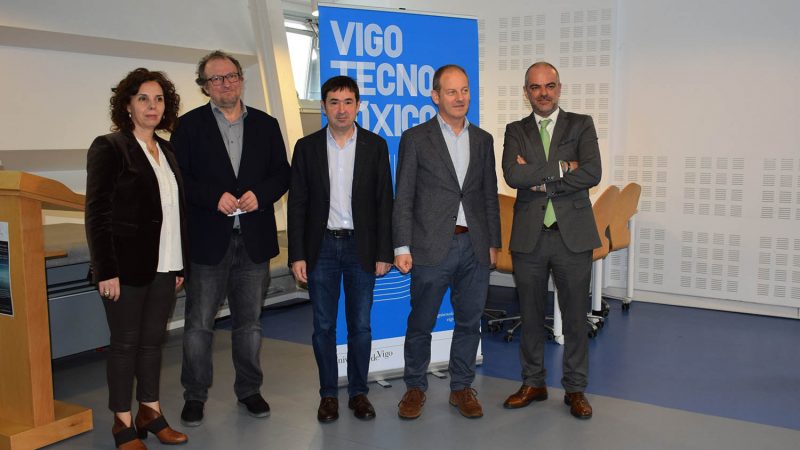Use oceanic plastic waste for the creation, by 3D printing, of eco-innovative components that can be reused by the maritime industry. They could be manufacture in just a few minutes, in port facilities as well as on board a ship. This is the philosophy with which the European project CircularSeas was born. A work financed with nearly two million euros of FEDER funds and in which the research group on Systems Engineering and Automation of the University of Vigo participates as partner, directed by the professor at the School of Industrial Engineering Julio Garrido.
The presentation of the project gathered this morning in the Miralles building, a good representation of all the parties involved, not only of the university community, but also of the other organizations that, for a few months now, have been collaborating in this research and which include the Port Authority of Vigo, a key element for the development of this work, and the Galician Institute for Economic Promotion, Igape. Garrido explained the details of the project and, next to him were, the Vice-Rector for Transfer, Consuelo Pérez; the director of the UVigo Marine Research Center and the Campus del Mar, Daniel Rey; the head of the Environment of Porto de Vigo, Alberto Jaraiz, and the general director of the Igape, Juan Manuel Cividanes who also participated in this presentation. They all underlined the great expectations that CircularSeas awakens in the naval and port industry, not in vain, that if the expected results are achieved, it would contribute to mitigate one of the biggest problems that society is currently facing and which refers to sea pollution by microplastics. “If once these microplastics are removed, they get add value and, even, they help to solve any mechanical problem that may arise on a ship. That has, without doubt, a very high value,” stressed the Vice-Rector for Transfer.
CircularSeas’s main objective is to promote the green economy by creating products, parts and components created from plastic waste collected by ships in their campaigns or derived from the main maritime industries: fishing, auxiliary fishing and aquaculture; shipyards and port management, and also water sports. “It is a question of using those plastics that are no longer being used, which are residual, and giving them value, studying how to prepare them so that, by 3D printing, they can be reused in the same maritime-port environment,” Garrido explained.
Eight partners from five countries
Eight partners from five countries participate: Spain, France, Portugal, United Kingdom and Ireland, in total six ports involved. The Basque research center Leartiker leads, belonging to the Basque Network of Science and Technology, specialized in innovation in polymer technology. ” They contacted with us so that we take charge, above all, of the part that has to do with the development of new machines, especially those that require precise trajectory control and the optimization of automated processes,” Garrido explained, thus emphasizing that the Vigo part of the project will focus, above all, on the development of new advanced machinery systems for the manufacture of plastic components.
Data collection at ports is nearing to completion
In the project, there are two well defined phases. The first, in which all the partners are already immersed, is common to the six participating nodes and consists of carrying out the field work. In this phase, each node is contacting companies and institutions in the maritime / port area, collecting information through visits and surveys. Once a selection of waste revaluation cases has been made, they will work with the rest of the nodes in the adaptation of printers and in the development of new equipment that adapts to the plastics and 3D printing process required, as well as their optimization. “Each node has already assigned a specific part of the study from the beginning. In our case it is the manufacture on board, that is to say, the intelligent adaptation of the trajectories of a machine -whose work supposes the accomplishment of precise movements- to the conditions on board, taking 3D printing as a specific case study “, the person in charge of the project in Vigo stressed.
Vigo will host thematic workshops and the final congress of the project
Although the Systems Engineering and Automation group is the only Galician participant, the high interest in this work meant that they had already received numerous offers of collaboration, from other research groups at the University and from technology centers, including the CSIC and the Vigo Oceanographic Center. In this sense, Garrido explained that over the next few months different thematic workshops will be held “in which we will undoubtedly ask them to participate as experts in different areas of the project: economy, sustainability, materials, etc.” Garrido indicated during the presentation, to which he also added that the congress of presentation of the final results will also be in Vigo in March 2022.
Multiple commercial examples demonstrate the viability of the project
The creation of new products from plastic waste is not something new and in other sectors there are already multiple experiences in this regard. Perhaps, the textile is one of the most active at the moment. “There are already commercial brands that make their own garments with this type of waste, and even with plastic waste exclusively from the sea. Examples can be also found in footwear ”, the person in charge of the project in Vigo explains, who stressed that the main difference that CircularSeas brings is that it focuses on the 3D printing process. “This option is not the best for mass production, although it is undoubtedly the one that allows maximum adaptability,” Garrido said.
Source: DUVI

